 W
WThe 28th Regiment at Quatre Bras is an oil painting on canvas from 1875, painted by Elizabeth Thompson. The painting is 97.2 centimeters (38.3 in) high and 216.2 centimeters (85.1 in) wide. It is in the National Gallery of Victoria, Melbourne, Australia.
 W
WThe Banquet of Cleopatra is a painting by Giovanni Battista Tiepolo completed in 1744. It is now in the National Gallery of Victoria in Melbourne, Australia. This is the first of three large paintings of the subject done by Tiepolo. In addition the much smaller oil studies or modelli for each survive.
 W
WThe Bar is a 1954 painting by Australian artist John Brack. The subject of the painting directly references Édouard Manet's 1882 work A Bar at the Folies-Bergère. It depicts a barmaid working in an Australian pub at the time of the "six o'clock swill". As in Manet's work, the patrons of the bar are shown in a reflection behind the barmaid. The work is considered a companion piece to Brack's 1955 work Collins St., 5 pm.
 W
WThe Block is a 1954 painting by Australian artist John Brack. The painting depicts the interior of an empty butcher's shop, including the eponymous butcher's block. It is one of a series of paintings—including The Barber's Shop (1952), The Fish Shop (1955) and Men's Wear (1955)—of small high street businesses.The tools of the trade – choppers, knives and meathooks – hang from the rails. The butcher’s block, centrally placed and painted in a darker tone, dominates the composition. Despite the rather grisly subject matter, Brack has achieved a small, perfectly contained and beautifully painted jewel-like interior. The detail of the brushwork, with its meticulous lines and opaque passages of thin paint in the background, the fine scratches incised into the block to indicate its use, and the artist’s handmade wooden frame, all converge in an exquisite synthesis
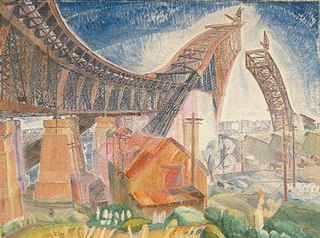 W
WThe Bridge in Curve is a painting completed in 1930 by Australian artist Grace Cossington Smith, depicting the Sydney Harbour Bridge during its construction. The work is now considered one of Australia's best modernist paintings, but was rejected from exhibition in 1930.
 W
WCahill Expressway is a 1962 painting by the Australian artist Jeffrey Smart. The painting depicts the Cahill Expressway, a motorway in inner Sydney. It is "considered by many to be one of his finest works" and "perhaps his best-known picture". The work has been described as "startling ... for its recognisability as an Sydney scene and doubly so for its timeless quality."
 W
WThe Car is a 1955 painting by Australian artist John Brack. The painting depicts a family in a car on a drive in a rural area. The painting shows the father looking at the road ahead while the mother and children look towards the viewer. While the whole car cannot be seen, the car itself is identifiable as a Triumph Mayflower. The landscape, seen through the windows of the car, has been said to be inspired by the work of his contemporary Fred Williams.
 W
WCollins St., 5 pm is a 1955 painting by Australian artist John Brack. The painting depicts office workers walking along busy Collins Street in Melbourne after finishing work for the day—"Blank-faced office workers hurry by like sleep-walkers, thinking only of the pubs or their homes in the suburbs". Brack conceived the work after reading T. S. Eliot's 1922 poem The Waste Land. It is considered a companion piece to Brack's earlier work The Bar.
 W
WComing South is a 1886 painting by the Australian artist Tom Roberts. The painting depicts migrants coming to Australia from Europe aboard a steamship. Roberts based the painting on sketches he had made when returning to Australia aboard the SS Lusitania in 1885 after four years abroad in Europe.
 W
WThe Crossing of the Red Sea is a painting by Nicolas Poussin, produced between 1633 and 1634. It depicts the crossing of the Red Sea by the Israelites, from chapter 14 of the book of Exodus. It was made as part of a pair of paintings commissioned by Amadeo dal Pozzo, Marchese di Voghera of Turin, a cousin to Cassiano dal Pozzo, Poussin's main sponsor in Rome. By 1685 the pair had passed to the Chevalier de Lorraine and in 1710 they were bought by Benigne de Ragois de Bretonvillers.
 W
WFootballer is a 1946 painting by Australian artist Sidney Nolan. It depicts an Australian rules footballer standing before a crowd of spectators at a football match. For many years the painting was thought to be a generic image of a footballer, however Nolan later revealed that the painting is based on Bill Mohr, a star player for the St Kilda Football Club during the 1930s.
 W
WThe Virgin and Child Reading is an oil painting of uncertain date. It is a mid-to-late 15th century imitation of the work of the Early Netherlandish master Jan van Eyck, possibly after a now-lost original painting by him from 1433 - another copy of the same work is now in the Colegiata church in Covarrubias, Spain. It is first documented in 1619, when it was in Sicily and then re-appeared in Charles Blundell's collection at Ince Blundell Hall near Liverpool early in the 19th century, meaning it is sometimes known as the Ince Hall Madonna. George Frederick Zink restored it there in 1922. It was acquired from the Weld-Blundell family by the National Gallery of Victoria (NGV) in Melbourne in 1922 using funds from the Felton Bequest.
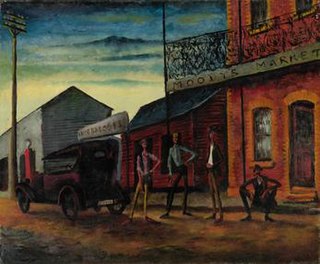 W
WMoody's pub is a 1941 painting by Australian artist Russell Drysdale. The painting depicts a pub in the Victorian town of Seymour.
 W
WThe North Wind is a painting by Australian painter Frederick McCubbin, thought to have been painted in around 1888. The painting depicts a young family—the woman and child in a dray, the man and a dog on foot—making "its way down a bush track, buffeted by the treacherous ‘north wind’".
 W
WNude With Dressing Gown is a 1967 painting by Australian artist John Brack. The painting depicts a nude woman putting on a dressing gown. Unusually for a Brack nude, the painting is a not a formal sitting; instead the subject is "caught ... in a more private moment as she modestly dons a gown".If his subject was not glowing with an almost fluorescent, irradiated green, this would be one of Brack's most sensual pictures. His model is lithe, adorned with a fashionable 1960s-style bob. She is far from Rubenesque, but the twist of hip is distinctly feminine. ... But any sensuality is counterbalanced by Brack's garish colouration.
 W
WOctober is an 1878 painting by Jules Bastien-Lepage, now in the National Gallery of Victoria in Melbourne. It is also known as Picking Potatoes, The Potato Gatherers or Woman Gathering Potatoes.
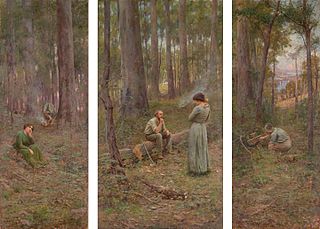 W
WThe Pioneer is a 1904 painting by Australian artist Frederick McCubbin. The painting is a triptych; the three panels tell a story of a free selector and his family making a life in the Australian bush. It is widely considered one of the masterpieces of Australian art.
 W
WThe purple noon’s transparent might is an 1896 oil on canvas landscape painting by Australian artist Arthur Streeton. The painting depicts the Hawkesbury River in New South Wales, looking toward the Blue Mountains. The work's title was taken from the poem Stanzas Written in Dejection, near Naples by Percy Bysshe Shelley.
 W
WThe Rescue (1855) is a painting by John Everett Millais depicting a fireman rescuing three children from a house fire, with their mother receiving them back into her arms.
 W
WIn 1842, British artist J. M. W. Turner painted three watercolours of the Rigi, a mountain in the Alps in Central Switzerland, which he had visited the previous summer. Widely regarded as some of his finest works, the watercolours capture the transitory effects of light and atmospheric conditions at the Rigi. According to John Ruskin, "Turner had never made any drawings [watercolours] like these before, and never made any like them again ... He is not showing his hand in these, but his heart."
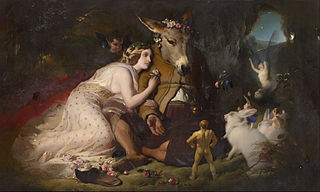 W
WScene from A Midsummer Night's Dream. Titania and Bottom is an 1851 oil-on-canvas painting by British artist Edwin Landseer. Landseer was mainly known for his paintings of animals: this is his only painting of a fairy scene. The painting depicts a scene from the third act of William Shakespeare's play A Midsummer Night's Dream. It has been in the collection of the National Gallery of Victoria in Melbourne, Australia since 1932.
 W
WA sergeant of the Light Horse is a 1920 painting by Australian artist George Washington Lambert. The portrait depicts an Australian soldier in Palestine during World War I. The National Gallery of Victoria states that the work is "recognised as an image that captured the spirit and character of the Australian soldier".
 W
WShearing the Rams is an 1890 painting by Australian artist Tom Roberts. It depicts sheep shearers plying their trade in a timber shearing shed. Distinctly Australian in character, the painting is a celebration of pastoral life and work, especially "strong, masculine labour", and recognises the role that the wool industry played in the development of the country.
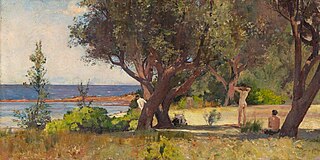 W
WThe Sunny South is a 1887 painting by the Australian artist Tom Roberts. The painting depicts a group of boys swimming naked at Ricketts Point at Beaumaris, Victoria, a suburb of Melbourne.
 W
WUlysses and the Sirens is an 1891 painting by Pre-Raphaelite artist John William Waterhouse. It is currently held in the National Gallery of Victoria, Melbourne, Australia.
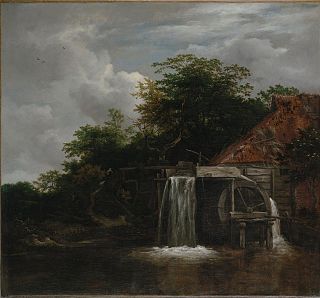 W
WThe Watermill is an oil on canvas painting by the Dutch landscape painter Jacob van Ruisdael. It is an example of Dutch Golden Age painting and is now in the collection of the National Gallery of Victoria.
 W
WThe Wheel of Fortune is an oil painting on canvas by the British Pre-Raphaelite painter Edward Burne-Jones, made from 1875 to 1883. The painting combines classical and medieval themes to present an allegory of the vagaries of life, a vanitas, with individual lives elevated or cast down as the wheel of fortune turns. Burne-Jones commented: "My wheel of Fortune is a true-to-life image; it comes to fetch each of us in turn, then it crushes us." The prime version has been in the collection of the Musée d'Orsay in Paris since 1980.